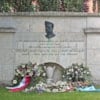
Svend Bartholin Paludan-Müller
The events of the morning of 26 May 1944 and the hours that followed, when Colonel Paludan-Müller stood his ground alone against the German supremacy, are like something out of a film.
When the Gestapo knocks on the door of the private residence of the head of the border gendarmerie, the operation doesn't go as expected.
The Danes' resistance against the German occupation is growing. The week before, there have been a number of executions of men from the resistance movement, and the day before, the German envoy and plenipotentiary Dr Best has given a speech in which he threatens to have 100 saboteurs and violent men executed if the sabotage does not stop.
It is early morning at 5.30 am and as part of the so-called police action, the colonel is to be arrested and brought in for questioning on suspicion of espionage and participation in an illegal military organisation. But Svend Bartholin Paludan-Müller has no intention of going along voluntarily and he is armed.
Paludan-Müller is not anti-German, because even though the almost combatless surrender on 9 April 1940 is a thorn in his side, he has managed to maintain a mutually respectful cooperation with the German border control. However, it is his obvious personal opinion that one should not invade foreign territory and his military background that forms the basis for the further course of events.
He has realised that it is only a matter of time before the Germans showes up at his door. His men, in the border gendarmerie, have previously been instructed during a parade not to get involved under any circumstances. This morning he is fully dressed and has an Krag-Jørgensen riffle, his service pistol and around 100 projectiles in his home.

Foto:Museum Sønderjyllands Mediearkiv
When Paludan-Müller hears that the German security police want to talk to him, he replies that they can meet him at the office at 10am.
Naturally, this answer doesn't suit them and the door is blown open - the first man to enter collapses, hit by a gunshot and dead on the spot. The other Germans retreat and Paludan-Müller barricades the door and manages to get his wife, 17-year-old daughter and the young house assistant to safety in the house. Meanwhile, two of the Germans have arrived at the local police station, where they call the command centre in Aabenraa for reinforcements - asking for bombs, grenades and all available manpower!
A fierce firefight ensues at the house and at one point, local pastor Hvidt manages to stop the shooting so he can get the women out of the house. Shortly afterwards, reinforcements arrive from Aabenraa and with a superiority of around 40 men to 1, the battle continues. At around 8.30am, the last shot is heard from inside the house, which at that time is lit up by the German's firebombs.
As word of Paludan-Müller's death spreads through the city, a spontaneous reaction takes the Germans by surprise and greatly affects the funeral - flags a set to fly at half-mast and shops and businesses close.
This gesture almost leads to disaster, as a forced reopening is narrowly averted. It also becomes very difficult to get Paludan-Müller's body extradited.


After several negotiations, they succeed, but the Germans does not want a Danish rebellion, so they demand that the funeral is not to take place in Gråsten or the Jutland town of Mou, where he was born. On 1 June 1944, Svend Bartholin Paludan-Müller is buried on Zealand at Snesere Church, and despite the fact that the funeral could not be announced, it is estimated that around 2,500 people attended.
On the anniversary of the death, the stairs leading up to the fire site are decorated with a memorial cross of red beech and white ribbons, as well as a number of wreaths. On 26 May 1946, the memorial wall in Gråsten was unveiled with the participation of the then Crown Prince and Crown Princess Frederik and Ingrid. Every year on 4 May, wreaths are laid for Colonel Svend Bartholin Paludan-Müller.
NB. This is only a short extract, so if you want to learn more, we recommend that you read Sven and Erhardt Larsen Sabroe's book; One man against the Gestapo.

